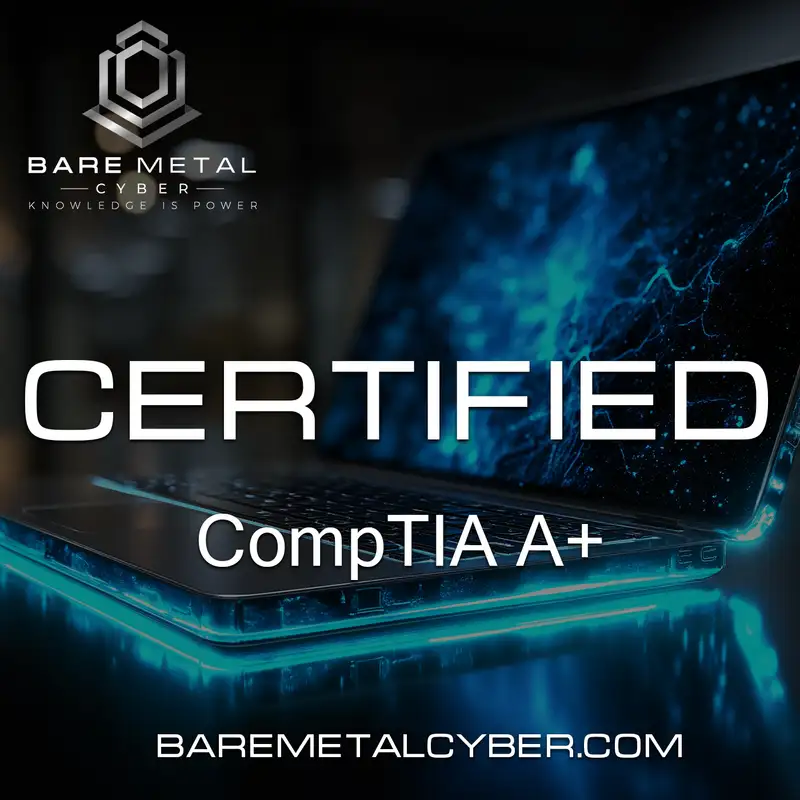All Episodes
Displaying 41 - 60 of 138 in total
Episode 41: Peripheral and Video Cables — HDMI, VGA, DVI
This episode focuses on the common video and peripheral cables that A Plus candidates must be able to identify, differentiate, and troubleshoot. We begin with HDMI, ex...

Episode 42: Hard Drive Interfaces — SATA, SCSI, NVMe, IDE
In this episode, we examine the interface types used to connect hard drives and solid-state drives to computing systems. We start with SATA, the most common interface ...

Episode 43: Adapter and Connector Types — RJ45, USB C, Molex, SC
This episode breaks down the many adapter and connector types you're likely to encounter in hardware installation and cabling questions. Starting with RJ45, we explore...

Episode 44: RAM Types — DDR Three, DDR Four, DDR Five, SODIMM, ECC
This episode focuses on the various types of system memory covered in the A Plus exam. We start by distinguishing between DDR 3, DDR 4, and DDR 5, outlining difference...

Episode 45: RAM Channel Configurations — Single through Quad
Understanding memory channel configurations is key to improving performance in both desktops and laptops, and this episode covers them in detail. We begin with single-...

Episode 46: HDD and SSD Speed, Form Factor, and Features
This episode explores how storage device performance and form factor impact system behavior, reliability, and installation. We begin by comparing rotational speeds of ...

Episode 47: SSD Interfaces — SATA, PCI E, M.2, and M SATA
This episode focuses exclusively on the different interface types used to connect SSD drives. We begin with SATA-based SSDs and describe how they offer improved speed ...

Episode 48: RAID Configurations — Zero, One, Five, Ten
This episode explores the most common RAID configurations tested on the A Plus exam and found in real-world systems. We begin with RAID 0, also known as striping, whic...

Episode 49: Flash Drives and Memory Cards
Flash memory is everywhere, from USB drives to camera storage, and this episode focuses on the types, capacities, and formats you’ll encounter on the A Plus exam. We s...

Episode 50: Optical Drives and Media Types
Although optical drives are less common today, they’re still covered on the exam and used in legacy and specialty environments. This episode explores the different typ...

Episode 51: Motherboards and Form Factors — ATX, Micro ATX, ITX
This episode focuses on one of the most important hardware components you'll encounter: the motherboard. We begin by breaking down motherboard form factors, including ...

Episode 52: CPU Sockets and Chipsets — Intel and AMD
Understanding how processors connect to the motherboard is critical for both real-world system builds and the A Plus exam. This episode dives into the various CPU sock...

Episode 53: Motherboard Interfaces — SATA, PCIe, Power Connectors
This episode covers the various internal interfaces found on a motherboard and what role each plays in system function. We begin with SATA connectors, explaining their...

Episode 54: Domain 4.0 Virtualization and Cloud — Overview
Virtualization and cloud computing are among the most transformative technologies in modern IT, and this episode introduces the concepts as laid out in the Core 1 exam...

Episode 55: Cloud Deployment Models — Public, Private, Hybrid, Community
This episode dives into the different ways cloud infrastructure can be deployed, each with its own use case, control level, and security implications. We begin with pu...

Episode 56: Cloud Service Models — Software as a Service, Platform as a Service, Infrastructure as a Service
Cloud service models describe what level of control and responsibility a customer has in a cloud environment, and this episode explains the big three: Software as a Se...

Episode 57: Key Cloud Features — Elasticity, Metering, Redundancy
What makes the cloud “cloud-like”? This episode answers that question by introducing key features that define cloud computing platforms. We start with elasticity—the a...

Episode 58: File Sync and Cloud-Based Storage Use Cases
In this episode, we explore one of the most common cloud services used by both consumers and businesses: cloud-based storage and file synchronization. You’ll learn how...

Episode 59: VDI and Remote Desktop Virtualization
Virtual Desktop Infrastructure, or VDI, allows users to interact with desktop environments hosted on centralized servers, and this episode unpacks how the technology w...

Episode 60: Application Virtualization and Legacy Support.
Application virtualization allows software to run in isolated containers, even if the underlying system doesn't support the app natively. In this episode, we explore h...
